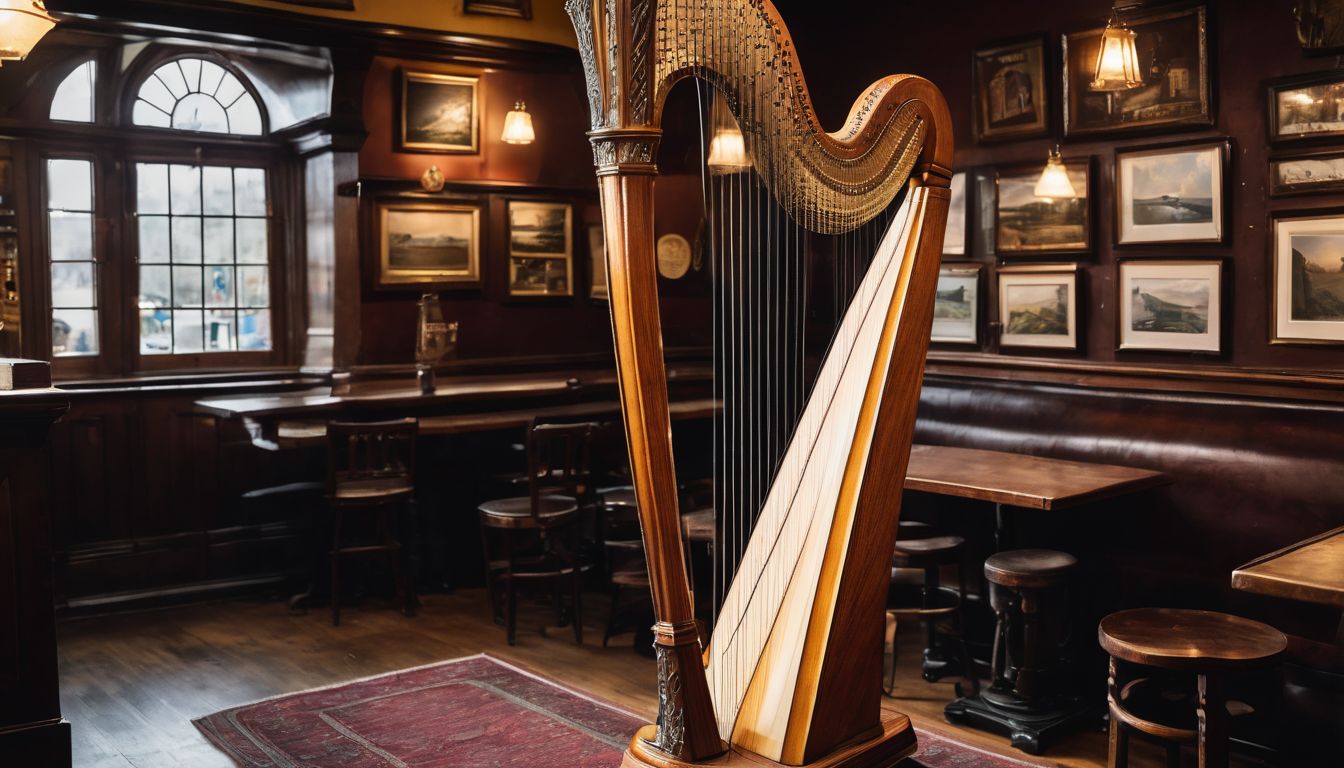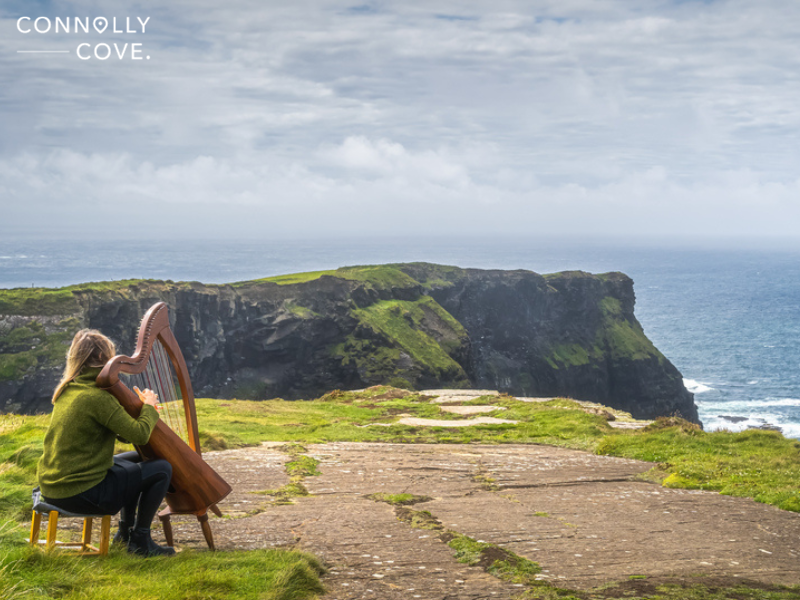The Irish Harp: A Sublime Melody Weaving Tales of History and Culture

Updated On: April 22, 2024 by Miranne Khaled
In the misty emerald embrace of Ireland and the rugged highlands of Scotland, a soulful melody hangs heavy in the air, woven from the very essence of the land. This is the song of the Irish harp, an instrument of timeless beauty and profound emotional resonance that has held a sacred place in the hearts of its people for over a thousand years.
More than just strings and wood, it stands as a symbol of national pride, whispering tales of ancient bards and vibrant cultural identity. Join us, then, on a journey through time, where we trace the intricate history, unveil fascinating facts, and explore the enduring significance of this enchanting instrument.
Our expedition begins in the misty dawn of Celtic legend, where the Irish harp first emerged, woven into the very fabric of Gaelic society. It is believed that early Gaels, arriving on the Emerald Isle around the 4th century AD, brought the seeds of this musical tradition.
Over centuries, the harp blossomed, evolving in design and playing technique and becoming an integral part of Irish and Scottish musical tapestries. It graced the halls of chieftains, weaving spells of magic with its delicate melodies, and it accompanied wandering bards, their songs etching themselves onto the soul of the land.
So, come, traveller, let us raise a toast to the Irish harp and embark on a voyage to discover its timeless allure.
Significance in Irish and Scottish Cultures

The Irish harp holds immense cultural significance, serving as the national emblem of Ireland. It appears on official documents, coins, and even the Presidential Seal. This iconic status is deeply rooted in history, as the harp was once a symbol of Gaelic nobility, representing the power and prestige of the ruling class.
In Irish mythology, the harp is closely associated with the legendary bard and warrior Oisín, son of the renowned warrior Fionn mac Cumhaill. Oisín’s harp, known as the Claíomh Críomhthainn or Harp of the Dagda, possessed magical qualities, capable of soothing hearts, inspiring courage, and even manipulating the tides.
Such tales further elevated the harp’s mythical aura and connection to the spiritual realm. During the 17th and 18th centuries, the Irish harp experienced a decline due to political and cultural upheavals. However, it experienced a revival in the late 19th century, thanks to the efforts of harp enthusiasts and luminaries such as Edward Bunting and Charlotte Milligan Fox. Their tireless efforts to transcribe and preserve traditional Irish harp music ensured its survival and rekindled interest in this cherished instrument.
Influence on Scottish Culture
In the verdant embrace of Ireland and the windswept hills of Scotland, a single instrument resonates across the tapestry of time – the Irish harp. With its ethereal whisper and poignant melodies, it’s not just a relic of history but a beating heart of national identity and soulful expression. But its magic extends far beyond the Emerald Isle, captivating the soul of Scotland through its cousin, the clarsach.
Just as the myths of Ireland swirl with harp-woven enchantments, so too do their Gaelic brethren across the Irish Sea. The clarsach, with its graceful curves and shimmering strings, shares a lineage with the Irish harp, yet boasts its unique voice. Centuries of Scottish bards and storytellers have poured their passion into its vibrant repertoire, from the melancholy lament of the “Piobaireachd” to the joyous jig of a Highland fling. Its playing techniques, too, speak of a distinct lineage, with intricate finger plucking and melodic embellishments painting stories in every note.
But the clarsach is not a museum piece, frozen in time. It’s a living, breathing testament to the resilience of Scottish culture. From castle halls to contemporary concert stages, its melodies soar, carrying the whispers of ancestors and igniting the hearts of modern audiences. Young hands learn its secrets, and the traditional tunes, like embers passed from generation to generation, continue to flicker with life. So, come, listen closely, and allow the song of the Irish harp, in all its diverse forms, to transport you to a land where history sings and stories dance at the fingertips of time.
Harp Symbolism and National Identity
The Irish harp’s association with Ireland’s national identity extends beyond its official emblems. The harp has been featured prominently in Irish literature, poetry, and art, serving as a powerful symbol of Irish culture, independence, and resistance against oppression. It symbolised Irish nationalism during the 18th and 19th centuries when Ireland was under British rule. The harp’s resilience and enduring popularity reflect the resilience and pride of the Irish people.
Traditions and Schools
The playing techniques and repertoire of the Irish harp have been passed down through generations, primarily through the oral tradition. Historically, harpers were often itinerant musicians, travelling from village to village, enchanting audiences with their skilful playing and improvisation.
However, much of the old music needed to be recovered due to the decline of the harping tradition in the 18th century. Today, dedicated schools and organisations, such as the Irish Harp Centre and the Historical Harp Society of Ireland, work tirelessly to revive and preserve traditional harping techniques and repertoire.
Construction and Design
The Irish harp evolved over time, and different styles and designs emerged. The most iconic design is the “cláirseach,” a triangular harp with a curved pillar and a resonating soundbox. This design is often associated with the traditional Irish harp.
Modern Irish harps are typically made of wood, with the soundbox constructed from various tonewoods such as maple, cherry, or walnut. As mentioned earlier, the strings are traditionally made of wire, which gives the instrument its characteristic sound.
Music and Genres
The repertoire of the Irish harp encompasses a wide range of musical genres, including ancient Celtic melodies, traditional Irish tunes, harp compositions from the 17th and 18th centuries, and contemporary compositions inspired by the classic style.
The music often evokes a sense of nostalgia, with haunting melodies that transport listeners to the misty landscapes of Ireland. The Irish harp is also known for its association with sean-nós singing, a traditional unaccompanied style of Irish singing, where the harp provides melodic and rhythmic accompaniment.
The Samuel Beckett Bridge
In the heart of Dublin, where the River Liffey reflects the city’s vibrant pulse, stands a bridge that sings – the Samuel Beckett Bridge. It’s not a symphony of stone and steel but a graceful, arcing silhouette that evokes the very soul of Ireland through its subtle yet striking resemblance to the Irish harp.
Unlike the static forms of traditional statues or monuments, the Samuel Beckett Bridge breathes with the city’s rhythms, mirroring the harp’s delicate strings. Like the harp’s melodies, these cables stretch across the span, carrying the pulse of traffic and pedestrians over the river. As the wind whispers through them, they hum a low, mournful song reminiscent of the ancient laments played on harps centuries ago.
But the beauty of the bridge lies beyond its physical form. It’s a bridge between past and present, honouring the rich heritage of Irish music while embracing the city’s modern spirit. Samuel Beckett, the bridge’s namesake, was a master of words who crafted stories that danced on the edge of silence, much like the haunting melodies of the harp. In this way, the bridge becomes a canvas for stories untold, inviting onlookers to weave their narratives into the air as they cross the threshold.
Beyond its symbolic connection to the harp, the bridge celebrates the instrument’s role as a social thread. For centuries, bards with harps wandered Ireland, sharing stories and connecting communities. Similarly, the Samuel Beckett Bridge connects the north and south sides of Dublin, fostering a sense of unity and reminding us that music, like the river, can flow freely, bridging divides and bringing people together.
Interesting Facts About the Irish Harp
With its captivating melodies and deep-rooted cultural significance, the Irish harp continues to inspire musicians and audiences alike. Its enduring legacy as a symbol of Ireland’s rich musical heritage and national identity reinforces the notion that music is a language that transcends time and connects us to our shared roots.
As we listen to its enchanting melodies, the Irish harp weaves a tapestry of history and culture, reminding us of music’s profound beauty and storytelling power.
Trinity College Harp
Within the peaceful sanctuary of Trinity College‘s Long Room, bathed in the golden glow of ancient tomes, rests a silent sentinel – the Trinity College Harp. It whispers of Brian Boru’s Harp or the O’Neill Harp and clings to its weathered frame, hinting at a lineage stretching back through the 14th or 15th-century mists.
Each intricate carving, each curve of weathered wood, whispers tales of ancient melodies and forgotten battles, reminding us of the enduring power of music to transcend time. It stands a silent ambassador, not just of history, but of a nation’s unwavering spirit, forever etched in the songlines of this timeless instrument.
Wire Strings
Unlike its cousin instruments, often strung with softer guts, the Irish harp boldly asserts its presence with vibrant wire strings of brass or steel. This unconventional choice isn’t mere caprice; it imbues the harp with a singular voice.
Gone are the muted whispers of other harps – the Irish harp rings with a captivating brightness, each note dancing on the air like sunlight on dew-kissed grass. This resonant clarity, a signature of its wire strings, carries the melodies across valleys and through bustling markets, ensuring its stories never miss a beat.
Turlough O’Carolan
Though fate stole Turlough O’Carolan’s sight at a young age, it could not dim the light that danced in his soul. Blind, his fingers spun magic on the Irish harp, weaving together threads of ancient Gaelic melodies with the elegance of Baroque flourishes.
Through O’Carolan’s legacy, the Irish harp transcended its role as a folk instrument, its melodies gracing aristocratic drawing rooms and echoing across tavern floors; this unlikely tapestry, born from the wellspring of a single man’s genius, became a cornerstone of the Irish harp repertoire, each note shimmering with the echoes of bards past and the promise of stories yet to be sung.
Harping Festivals
The verdant isle of Ireland, where the harp’s melody has danced with the wind for centuries, erupts in joyous yearly celebration at numerous harping festivals. Among these vibrant gatherings, the Scoil na gCláirseach (Harp School), hosted by the esteemed Historical Harp Society of Ireland, stands out as a beacon for seasoned players and aspiring bards.
Here, in the heart of this ancient tradition, legendary masters share their wisdom, their weathered hands guiding eager students through the secrets of the cláirseach. Days are filled with the sweet symphony of strings, evenings thrum with the echoes of laughter and shared stories, and under the starlit sky, the music weaves a tapestry of belonging, reminding all that the Irish harp’s song is a living flame, passed from generation to generation, forever burning bright.
The Irish harp, with its captivating history, cultural significance, and mesmerising melodies, remains a cherished symbol of Ireland and a testament to the enduring power of music. Its enchanting resonance inspires musicians and audiences worldwide, forging a bridge between the past and the present and keeping the spirit of Celtic traditions alive.






